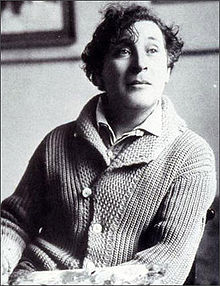Marc Chagall’s real name is Moses. The biblical name Moses is as old as the five hundred year old tablets that the commandments were etched upon. To many, Chagall lithographs are as eternal in style as the words on those tablets are constant in meaning.
The biblical Moses was as dedicated to enlightening his people as Marc Chagall was to mastering the art of printmaking. Chagall’s commitment to lithography spanned most of his life with the production of over one thousand lithographs. The study of many of his prints reveals a transcendental quality that makes Chagall the Moses of lithography. See Marc Chagall’s biography also.
 Picture courtesy of wikipedia |
Romeo and Juliet
Take the swooping flight that characterises much of Chagall’s
work, especially in the popular lithograph of Romeo and Juliet. The lovers
embrace as their love lifts them beyond the earth into a dreamscape of vivid
colour and everlasting beauty, further enhanced by the Parisian structures
that make up the background. Although distant, the landmarks are a foundation
of comfort and stability that promotes enduring love. Hanging like a golden
moon to treasure, Chagall captures the secret fantasies that universal lovers
entertain when they embrace. Chagall lithographs portray a tenderness and
understanding for the human condition, an attribute that endears many to his
prints.
Standing in front of a wall of Chagall lithographs is mesmerising. His presence in several of the world’s galleries has most visitors pondering the true meaning behind the artist’s impressions. However, perhaps Chagall’s work should not be taken so seriously. Dancing figures, cuddling couples, an assumed lyric extending from musical instruments and the floating heads of peaceful, smiling lambs are typical trademarks of Chagall’s playful style. His lithographs serve as abstractions that seep into our souls, and whose hidden messages are like a salve to our intellect.
Daphnis and Chloe
Take the fluidity of Daphnis and Chloe, two bodies floating like
one entity of love struck by the bow of a fluttering angel. The richness of
colour speckled across the lithograph typifies Chagall’s style. Although
the colour is dense, the lithograph maintains a feeling of lightness. Whether
it presents the onset of innocent love, successful courtship or a couple’s
everlasting bliss, the intention can only be determined by the viewer. This
level of skill makes Chagall one of the best lithographers in contemporary
art history.
Mezuzah
Returning to Moses, Chagall indeed created a piece based on the Ten Commandments,
called Mezuzah. Comprising twelve colours, it is one of Chagall’s most
vivid lithographs. Gone are the vast stretches of white space - this is Chagall
at his liberal best. The Menorah at the top of the composition most likely
symbolises the creation of the world; behind it is a bush which could be interpreted
as the burning bush, a biblical representation of the incident when God appeared
to Moses as a burning bush. To Chagall, the light from the menorah, or the
flame from the burning bush, are one and the same - one God only, regardless
of religion. Chagall’s interest in Jewish practices inspires him to
present the print as a ‘mezuzah’, a small, elongated object that
is normally set on the door frame of Jewish homes.
Doves, animals and floating entities fill the mid to top section of the lithograph
in true Chagall surreal style, whilst the people of Israel remain still and
grounded at the bottom. Grounded forms are not a common feature of Chagall
lithographs, so when they do appear, it is purposeful; they usually carry
a message. In Mezuzah, one might deduce that those who are lost, like the
Israelites in the bible, will remain on earth, while those who transcend the
earth, like Chagall’s many lovers, will be closer to heaven and God.
Although affected by his background and upbringing, as reflected in his imagery,
Marc Chagall was more an advocate of surrealism than any other art movement.
He believed that his inspiration came from a fourth dimension. Considering
the soulful connection that arises from viewing his lithographs, this assumption
holds true. Like the important messages from Moses the prophet, the meaningful
lithographs from Chagall the artist continue to transcend us today.
About the Author
Julie Gladstone is an aspiring artist and avid Marc Chagall fan. She provides content for the Marc Chagall Paintings website.